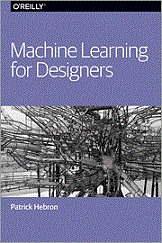
|
FreeComputerBooks.com
Links to Free Computer, Mathematics, Technical Books all over the World
|
|
- Title Machine Learning for Designers
- Author(s) Patrick Hebron
- Publisher: O'Reilly Media Inc. (June 09, 2016)
- Hardcover/Paperback N/A
- eBook PDF, ePub, and Kindle (Mobi)
- Language: English
- ISBN-10: N/A
- ISBN-13: 978-1491956205
- Share This:

|
Machine learning is no longer just a tool for data scientists. By taking advantage of recent advances in this technology, UI and UX designers can find ways to better engage with and understand their users. This O'Reilly report not only introduces you to contemporary machine learning systems, but also provides a conceptual framework to help you integrate machine-learning capabilities into your user-facing designs.
Using tangible, real-world examples, author Patrick Hebron explains how machine-learning applications can affect the way you design websites, mobile applications, and other software. You’ll learn how recent advancements in machine learning can radically enhance software capabilities through natural language processing, image recognition, content personalization, and behavior prediction.
- Leverage machine-generated user insights to provide a more personalized customer or user experience
- Spot opportunities for the integration of machine-learning capabilities into existing designs and platforms
- Choose the right machine-learning platforms or services
- Design for the probabilistic and often imprecise nature of machine-generated data
- Stay up to date with advancements in the field and spot emerging opportunities for machine learning-aided design
- Patrick Hebron is a Scientist-in-Residence and Adjunct Graduate Professor at NYU’s Interactive Telecommunications Program.
- Machine Learning
- Artificial Intelligence
- Computer and Machine Vision
- Data Analysis and Data Mining
- Neural Networks
- Books by O'Reilly®
 Related Articles:
Related Articles:
- Rethinking Design Tools in the Age of Machine Learning (Patrick Hebron)
- Applications Of Machine Learning For Designers (Lassi A Liikkanen)
-
 Foundations of Large Language Models (Tong Xiao, et al.)
Foundations of Large Language Models (Tong Xiao, et al.)
This is a book about Large Language Models (LLM). It primarily focuses on foundational concepts rather than comprehensive coverage of all cutting-edge technologies: pre-training, generative models, prompting techniques, and alignment methods.
-
 Linear Algebra for Computer Vision, Robotics, and Machine Learning
Linear Algebra for Computer Vision, Robotics, and Machine Learning
This book provides the mathematical fundamentals of linear algebra to practicers in computer vision, machine learning, robotics, applied mathematics, and electrical engineering.
-
 Machine Learning in Production: From Models to Products
Machine Learning in Production: From Models to Products
This book shows them how to assess it in the context of the business’s goals, reframe it to work optimally for both the data scientist and the employer, and then execute on it. Packed with real-world examples that take you from start to finish.
-
 Interpretable Machine Learning: Black Box Models Explainable
Interpretable Machine Learning: Black Box Models Explainable
This book explains to you how to make (supervised) machine learning models interpretable. The book focuses on machine learning models for tabular data (also called relational or structured data) and less on computer vision and NLP tasks.
-
 Multi-Agent Reinforcement Learning (Stefano V. Albrecht, et al.)
Multi-Agent Reinforcement Learning (Stefano V. Albrecht, et al.)
The first comprehensive introduction to Multi-Agent Reinforcement Learning (MARL), covering MARL’s models, solution concepts, algorithmic ideas, technical challenges, and modern approaches.
-
 Distributional Reinforcement Learning (Marc G. Bellemare, et al)
Distributional Reinforcement Learning (Marc G. Bellemare, et al)
Distributional reinforcement learning is a new mathematical formalism for thinking about decisions. This first comprehensive guide provides a new mathematical formalism for thinking about decisions from a probabilistic perspective.
-
 Mathematical Analysis of Machine Learning Algorithms (Tong Zhang)
Mathematical Analysis of Machine Learning Algorithms (Tong Zhang)
This self-contained textbook introduces students and researchers of AI to the main mathematical techniques used to analyze machine learning algorithms, with motivations and applications.





